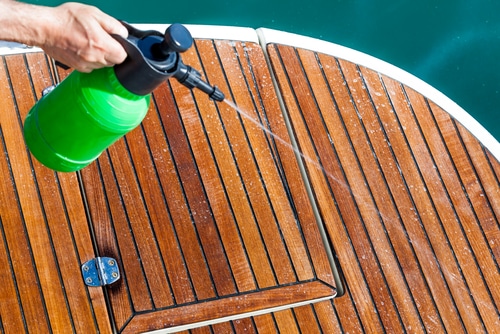Before You Store Your Boat: Boat Cleaning Tips
Boat Cleaning Tips | from BoatersWorld.com
 Before you store your boat at Patterson’s Self Storage, we suggest that you give it a good cleaning. We found some great tips for maintaining your boat!
Before you store your boat at Patterson’s Self Storage, we suggest that you give it a good cleaning. We found some great tips for maintaining your boat!
The main point in this article is to learn to clean your boat ‘smarter’, not ‘harder’. While a little ‘elbow grease’ is always good, if you clean your boat every time you use it before you store your boat, you do not have to spend hours doing these regular cleanings. With the right equipment, a quick boat cleanup after each use can be easy and a more efficient way to maintain your boat and keep it looking new.
Choose the Right Cleaning Equipment
Before selecting your cleaning equipment and products, consider the type of boat you have and its composition. For most situations, a brush with medium-soft bristles is your best bet. Make sure the bristle material is durable and strong enough to withstand repeated use, sun exposure, cleaning agents and salt water. In addition to a good scrub brush, be sure to have other necessities, such as a bucket (large enough for your brush), washing pads, a mop, sponges, chamois cloths and towels handy. Store these items in the same place each time, so you won’t have to search for them. You could actually store them on your boat if you have a place to do so.
Select a Good, Environmentally-Friendly Soap
Select a soap that will be tough on dirt, grime, salt and fish blood, yet easy on the environment. Don’t use the mild soap you would for cleaning dishes at home. Instead, select an effective, biodegradable cleaning agent with a neutral pH factor. If you use your craft in salt water, it’s especially important to use soap and fresh water to completely remove the corrosive salt build-up that can eat away at your boat. Be sure to follow the written instructions on the cleaning product regarding dilution and general usage. Be aware that certain “super concentrated” detergents may not be suitable for your boat, as these cleansers can strip away and damage finishes when left on for extended periods of time.
Get Ready for Some Good Clean Fun
Once you have the right cleaning tools and soap at your fingertips, it’s time to start cleaning. While you’ll still have to supply some “muscle,” using the proper equipment and soap will make giving your boat a bath an easier, quicker process. Before you think about applying any cleaning agents or touching the hull with a scrub brush, make sure you rinse the entire boat off completely. Whatever you do, never scrub a dry boat or you will risk damaging the finish or gel coat. When you clean, work from the top down. Lather up with a sponge soaked in the soapy solution, scrub, and rinse sections of your boat at a time. If you try to apply a soap and water to the entire boat at once, portions may dry before you can get around to them for scrubbing. If you have an outboard-powered boat, don’t forget to lather up and rinse off the motor as well as the lower drive unit, prop area and motor mounts, where corrosive salt and dirt tends to accumulate. When it comes to scrubbing the deck, you can use the same cleaning solution you use for your hull and your long-handled scrub brush. Some boat owners choose to scrub their decks with bleach, however, this is a toxic substance that’s harmful to the environment. For more environmentally friendly deck cleaning, use a Borax or Hydrogen Peroxide solution instead.
Soak Things Up
Use soft drying cloths that are highly absorbent and will soak up water without stripping or scratching. Chamois cloths or drying mops made of chamois material are good choices. To avoid “spotting,” be sure to dry off your boat immediately after washing and rinsing.
Wax On, Wax Off
Once you have dried off your boat completely, you may want to apply a quality wax and buff to shine and protect the fiberglass. It’s not really necessary to wax your boat after every use, but this should be done at least once or twice during the season to preserve the luster of the hull and protect against the elements and impurities. Use a quality carnauba wax and apply several coats. This will help protect your boat against the elements year round as you store your boat at outdoors at Patterson’s self storage.
Glass and Perspex Windows
A simple water and vinegar solution works well as a glass cleanser, and it’s easy on the environment. If glass and Perspex is heavily scratched, not much can be done in the way of repairs. The best course of action is to guard against damage in the first place by applying a clear silicon spray or polish to the windows and cleaning them with a soft, non-abrasive cloth.
Making Your Metal Shine
There are many quality cleaners and sealants available for keeping the chrome and stainless steel on your boat protected, shiny and bright. After applying a light film on your brightwork, let sit for about 15 to 30 minutes. Then, wipe off with a clean cloth. After cleaning, you may also want to apply a quality wax sealer/protectant to create a protective barrier against the harsh elements. If your boat’s metalwork is pitted or oxidized, apply a quality metal wax and leave it on the problem area overnight. In the morning, take a piece of fine bronze wool and gently scrub off the wax applied to the pitted or oxidized area. This process, repeated several times, should make a considerable difference.
 Taking Care of Teak
Taking Care of Teak
If you have teak on your boat, regular care will be required to maintain the original rich color and protect the wood. For various reasons, it’s best to varnish your teak. Instead, wash it off with the mild detergent used for the hull, rinse, dry, and apply teak oil. If the teak is worn and has lost some of its color, rub it gently with sandpaper (a heavier grade at first, followed by a finer grade). Once the sanding is completed, clean off the wood, allow it to dray and apply teak oil. Performing this kind of maintenance will go a long way in keeping your boat’s wood looking like it should.
Vinyl Upholstery
First, clean off your boat’s vinyl upholstery with a damp cloth to remove grime, dirt and salt. You may want to follow this by applying a quality vinyl cleaners/protectant and again wiping off the surface. Once the upholstery is free of dirt and grime, apply a light film of spray-on furniture polish and wipe with a clean cloth. This should help guard against stains and preserve the life of your boat’s upholstery. If mildew stains have formed on your vinyl upholstery, use a deck brush with medium-soft bristles and scrub with a water and ammonia mixture (4 parts water to one part ammonia). Follow with a freshwater rinse, dry, and repeat this process if necessary. For tougher cases, several effective commercial stain removers appropriate for use on vinyl upholstery are available.
Carpeting Cleaning
If the cabin portion of your boat is carpeted, you should vacuum and spot clean this area periodically. Using the specialized hose attachments will help you remove dust and dirt from hard to reach places. Start from the front of the cabin area and work toward the stern. This way you won’t be stepping on areas you have already cleaned. To avoid dirt or stains on your boat’s carpet, its best to avoid tracking dirt or fish blood from the deck in the first place. If the carpet is already stained or soiled, use a quality stain remover (following the manufacturer’s instructions), followed by a steam-cleaning with a carpet machine, if possible.
Cleaning/Degreasing Your Engine
It’s important to make cleaning your boat’s engine part of your annual winterization ritual at the end of the season. Some boat owners choose to do this themselves, while others opt to have this done, along with other winterization tasks, by an experienced mechanic before storing your boat during the winter months. A quality engine cleaner/protectant, such as WD-40 or Boeshield T-9, used in combination with a cleaning cloth, is usually sufficient for removing accumulated dirt, grime and grease. These products also protect engine parts by creating a protective shield from moisture. If it’s an older engine with a considerable amount of build-up, you may need to employ a more powerful de-greaser, such as “Gunk.” Whatever solutions you use, be sure to follow the manufacturer’s instructions carefully, and protect or seal off electrical engine parts first. If grease is removed from key engine areas that require this lubrication, be sure to re-apply some to these points upon completion of your cleaning.
The boating tips in this article were found at the American Boating Association’s website, and most of this content originated at boatersworld.com. The American Boating Association | PO Box 690 | New Market, MD 21774





Leave A Comment